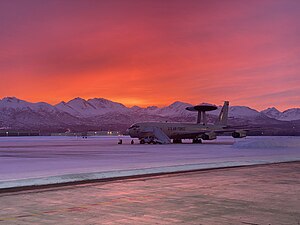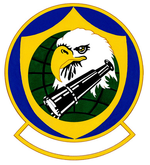
Royal Air Force Debach or more simply RAF Debach is a former Royal Air Force station located at Debach, 3 miles (4.8 km) northwest of Woodbridge, Suffolk, England.

The 458th Air Expeditionary Group is a provisional United States Air Force unit assigned to United States Air Forces in Europe to activate or inactivate as needed. The most recent known activation of the unit was at Ramstein Air Base, Germany in 2011.

The 493d Bombardment Group is a former United States Army Air Forces unit that was assigned to the 92d Bombardment Wing during World War II. It the last bombardment group to be assigned to Eighth Air Force. It flew combat missions in the strategic bombing campaign against Germany until shortly before V-E Day, then returned to the United States for inactivation. In 2002, the group was converted to provisional status as the 493d Air Expeditionary Group and assigned to Air Mobility Command to activate or inactivate as needed.

The 168th Air Refueling Squadron is a unit of the Alaska Air National Guard's 168th Air Refueling Wing stationed at Eielson Air Force Base, Fairbanks, Alaska. The 168th has been equipped with various models of the Boeing KC-135 Stratotanker since activating in 1986.

The 961st Airborne Air Control Squadron is part of the 18th Wing at Kadena Air Base, Japan. It operates the E-3 Sentry aircraft conducting airborne command and control missions.

The 965th Airborne Air Control Squadron is part of the 552d Air Control Wing at Tinker Air Force Base, Oklahoma. It operates Boeing E-3 Sentry aircraft conducting airborne command and control missions.
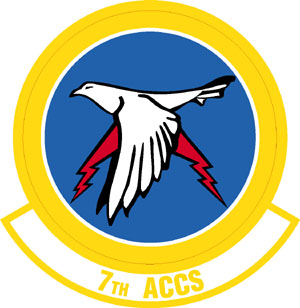
The 7th Expeditionary Airborne Command and Control Squadron is part of the 379th Air Expeditionary Wing at Al Udeid Air Base, Qatar. It operates the E-8 Joint STARS aircraft, conducting airborne command and control missions. The squadron has performed the airborne command and control mission since 1968, when it was activated in Vietnam. In 1985, the squadron was consolidated with three earlier units: The 7th Ferrying Squadron, which helped deliver aircraft to the Soviet Union from 1942 until 1944; the 7th Combat Cargo Squadron, which performed combat airlift missions in the Southwest Pacific Theater from 1944 until V-J Day, then became part of the Occupation Forces in Japan until inactivating in 1948; and the 7th Air Transport Squadron, Special, which provided airlift support for the United States' special weapons program from 1954 to 1966.

The 55th Air Refueling Squadron is an inactive United States Air Force unit. It formerly operated both the combat crew training school and central flight instructor course for Boeing KC-135 Stratotanker at Altus Air Force Base, Oklahoma.

The 906th Air Refueling Squadron is an active United States Air Force unit. It is an active associate squadron and part of the 375th Air Mobility Wing at Scott Air Force Base, Illinois.

The 909th Air Refueling Squadron is part of the 18th Wing at Kadena Air Base, Japan. It operates the KC-135 Stratotanker aircraft conducting air refueling missions.

The 448th Supply Chain Management Group is an inactive United States Air Force unit. Its last assignment was to the 448th Supply Chain Management Wing at Tinker Air Force Base, Texas, where it was inactivated on 30 June 2010.

The 511th Bombardment Squadron is an inactive United States Air Force unit. It was last assigned to the 351st Bombardment Group at Fairfax Field, Kansas, where it was inactivated on 27 June 1949.
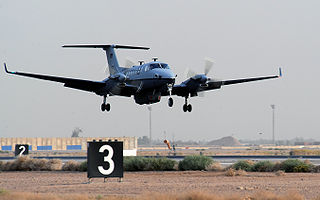
The 361st Expeditionary Reconnaissance Squadron is a provisional United States Air Force unit. It was most recently assigned to the 451st Air Expeditionary Group at Kandahar Airfield, Afghanistan, where it was inactivated on 1 September 2014.
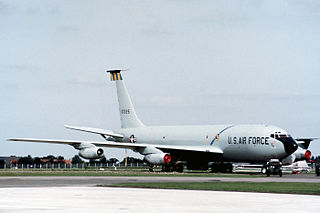
The 407th Air Refueling Squadron is an inactive United States Air Force unit. It was last assigned to the 42nd Bombardment Wing at Loring Air Force Base, Maine, where it was inactivated on 1 October 1990.

The 920th Air Refueling Squadron is an inactive United States Air Force unit. It was last assigned to the 379th Bombardment Wing at Wurtsmith Air Force Base, Michigan where it was inactivated on 30 September 1992.

The 41st Expeditionary Air Refueling Squadron is a provisional United States Air Force unit. It was last assigned to the 380th Operations Group at Griffiss Air Force Base, New York, where it was inactivated on 15 February 1993.

The 720th Bombardment Squadron is an inactive United States Air Force unit. It was last assigned to the 450th Bombardment Wing at Minot Air Force Base, North Dakota, where it was inactivated on 25 July 1968.

The 860th Bombardment Squadron is a former United States Army Air Forces unit that was assigned to the 493d Bombardment Group during World War II. It was part of the last bombardment group to be assigned to Eighth Air Force. It flew combat missions until V-E Day, then returned to the United States for inactivation. In 1985, the squadron was consolidated with the 660th Bombardment Squadron, a Strategic Air Command unit that flew Boeing B-47 Stratojets during the Cold War. Although the two squadrons were consolidated as the 967th Airborne Warning and Control Squadron, they have never been active under that designation.

The 788th Tactical Fighter Squadron is an inactive United States Air Force unit. During World War II, as the 788th Bombardment Squadron, it was assigned to the 467th Bombardment Group as a Consolidated B-24 Liberator squadron in 1943. After training in the United States, it moved to the European Theater of Operations the following year. It saw combat until the surrender of Germany in May 1945, earning a French Croix de Guerre with Palm for its actions contributing to the liberation of France. From May to August 1944, the squadron was detached to the 801st Bombardment Group (Provisional) engaging in Operation Carpetbagger operations. After V-E Day, the squadron returned to the United States and transitioned into the Boeing B-29 Superfortress It was inactivated on 4 August 1946 at Clovis Army Air Field, New Mexico.

The 968th Expeditionary Airborne Air Control Squadron is a provisional unit of the United States Air Force, flying the Boeing E-3G Sentry. Since March 2022, the squadron is stationed at Prince Sultan Air Base, Saudi Arabia. It has been activated twice since the September 11 terrorist attacks.

